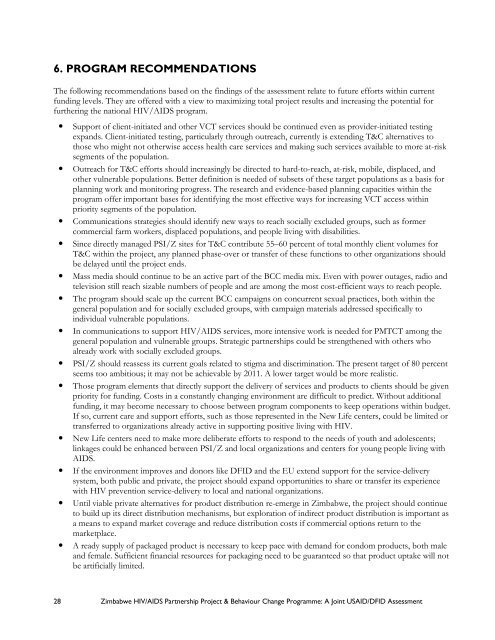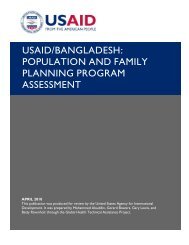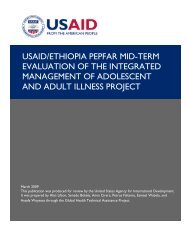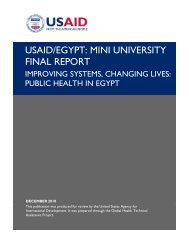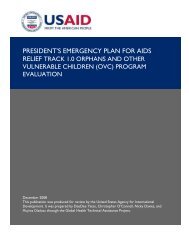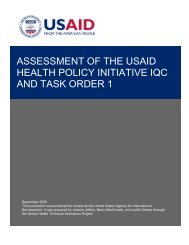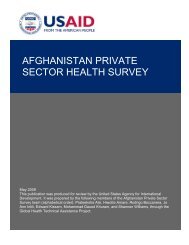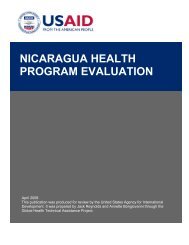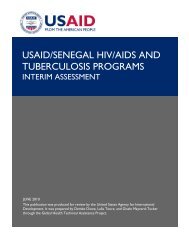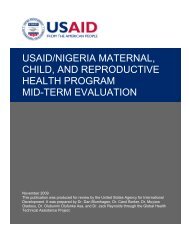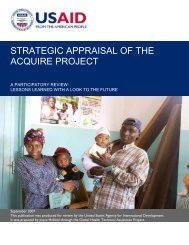Zimbabwe HIV/AIDS Partnership Project & Behaviour Change
Zimbabwe HIV/AIDS Partnership Project & Behaviour Change
Zimbabwe HIV/AIDS Partnership Project & Behaviour Change
- No tags were found...
You also want an ePaper? Increase the reach of your titles
YUMPU automatically turns print PDFs into web optimized ePapers that Google loves.
6. PROGRAM RECOMMENDATIONSThe following recommendations based on the findings of the assessment relate to future efforts within currentfunding levels. They are offered with a view to maximizing total project results and increasing the potential forfurthering the national <strong>HIV</strong>/<strong>AIDS</strong> program.• Support of client-initiated and other VCT services should be continued even as provider-initiated testingexpands. Client-initiated testing, particularly through outreach, currently is extending T&C alternatives tothose who might not otherwise access health care services and making such services available to more at-risksegments of the population.• Outreach for T&C efforts should increasingly be directed to hard-to-reach, at-risk, mobile, displaced, andother vulnerable populations. Better definition is needed of subsets of these target populations as a basis forplanning work and monitoring progress. The research and evidence-based planning capacities within theprogram offer important bases for identifying the most effective ways for increasing VCT access withinpriority segments of the population.• Communications strategies should identify new ways to reach socially excluded groups, such as formercommercial farm workers, displaced populations, and people living with disabilities.• Since directly managed PSI/Z sites for T&C contribute 55–60 percent of total monthly client volumes forT&C within the project, any planned phase-over or transfer of these functions to other organizations shouldbe delayed until the project ends.• Mass media should continue to be an active part of the BCC media mix. Even with power outages, radio andtelevision still reach sizable numbers of people and are among the most cost-efficient ways to reach people.• The program should scale up the current BCC campaigns on concurrent sexual practices, both within thegeneral population and for socially excluded groups, with campaign materials addressed specifically toindividual vulnerable populations.• In communications to support <strong>HIV</strong>/<strong>AIDS</strong> services, more intensive work is needed for PMTCT among thegeneral population and vulnerable groups. Strategic partnerships could be strengthened with others whoalready work with socially excluded groups.• PSI/Z should reassess its current goals related to stigma and discrimination. The present target of 80 percentseems too ambitious; it may not be achievable by 2011. A lower target would be more realistic.• Those program elements that directly support the delivery of services and products to clients should be givenpriority for funding. Costs in a constantly changing environment are difficult to predict. Without additionalfunding, it may become necessary to choose between program components to keep operations within budget.If so, current care and support efforts, such as those represented in the New Life centers, could be limited ortransferred to organizations already active in supporting positive living with <strong>HIV</strong>.• New Life centers need to make more deliberate efforts to respond to the needs of youth and adolescents;linkages could be enhanced between PSI/Z and local organizations and centers for young people living with<strong>AIDS</strong>.• If the environment improves and donors like DFID and the EU extend support for the service-deliverysystem, both public and private, the project should expand opportunities to share or transfer its experiencewith <strong>HIV</strong> prevention service-delivery to local and national organizations.• Until viable private alternatives for product distribution re-emerge in <strong>Zimbabwe</strong>, the project should continueto build up its direct distribution mechanisms, but exploration of indirect product distribution is important asa means to expand market coverage and reduce distribution costs if commercial options return to themarketplace.• A ready supply of packaged product is necessary to keep pace with demand for condom products, both maleand female. Sufficient financial resources for packaging need to be guaranteed so that product uptake will notbe artificially limited.28 <strong>Zimbabwe</strong> <strong>HIV</strong>/<strong>AIDS</strong> <strong>Partnership</strong> <strong>Project</strong> & <strong>Behaviour</strong> <strong>Change</strong> Programme: A Joint USAID/DFID Assessment


